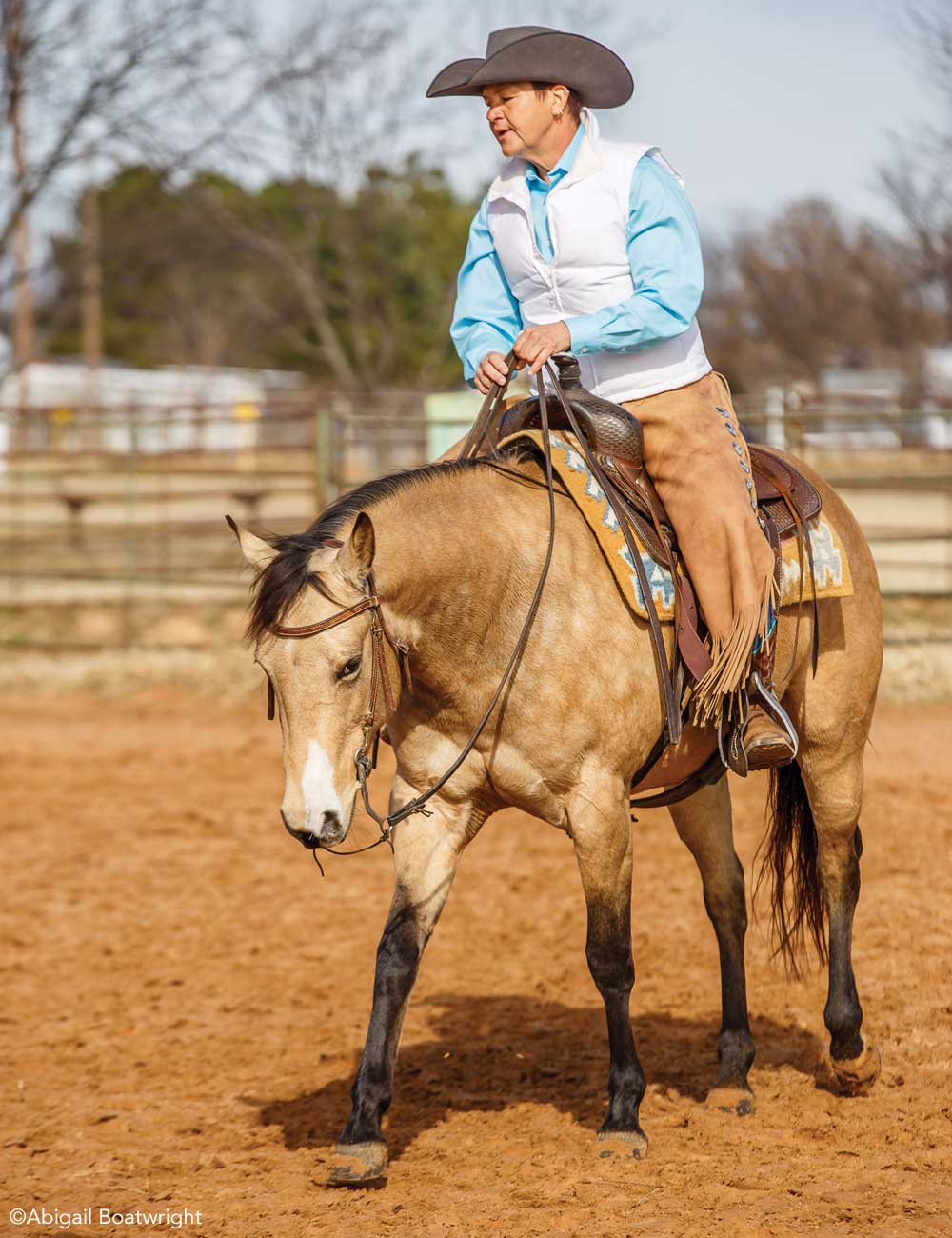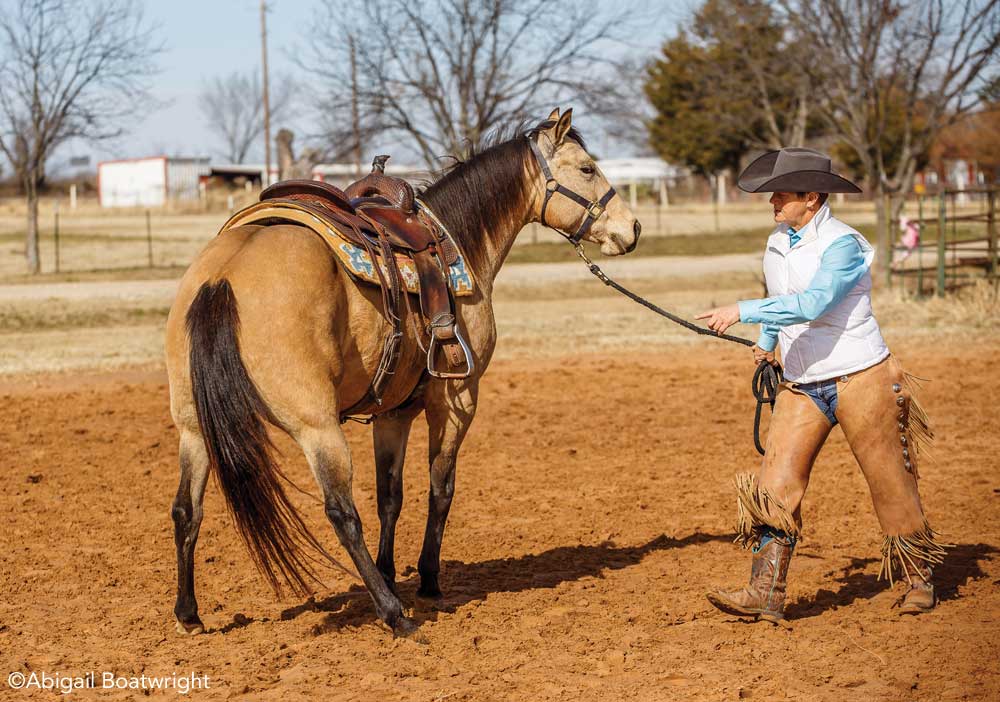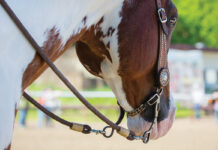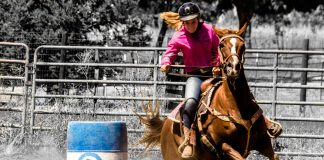Any horse can buck—that’s just how they’re wired. Whether you’re logging a young horse’s very first trip under saddle or trying to stay aboard a frisky older horse, knowing how to minimize, ride through, and maybe even prevent future bucking are important skills for any rider. Brenda Hilgenkamp explains how she handles a bronc situation.
- Horses can buck out of fear, pain, or because they have an excess of energy.
- Depending on the situation, you may want to bring your horse to a walk or stop when he starts bucking, but often the best course of action is to push him forward into a circle, according to trainer Brenda Hilgenkamp.
- Doing different types of groundwork with a horse before you get in the saddle can be helpful in reducing the horse’s propensity to buck while you’re riding.
Why Bucking?
“It’s a survival instinct, a defense mechanism,” says Hilgenkamp. “You don’t want your horse to buck, and you’re doing everything to prevent it, but that’s still how they’re made. It’s a fight-or-flight behavior.”

Riding down the trail, your horse could walk past a ground-level hornet’s nest and get stung—in that case, a buck is a panic and pain reflex, says Hilgenkamp. Cold or windy weather can also cause a horse to hump up and buck a bit if he’s feeling fresh.
A green youngster could buck at something he hasn’t seen before. Horses can buck out of fear, out of pain if the saddle or bit isn’t fitting well, or if they haven’t had their teeth floated. And they can buck if they’re fresh and haven’t had enough exercise.
“If you have a horse that’s thrown a buck at you maybe once in a blue moon, it might be your horse reacting to something,” says Hilgenkamp. “But if it’s a horse that’s bucking a lot, you need to find out the reason so you can eliminate it.”
Pay Attention
You might think that after a horse bucks four or five times in a row and you come off, it was that last buck that did it. But Hilgenkamp says it’s probably the first little jump that got you off-center, and you never caught back up.
“When you ride your horse, you need to be mentally present with him,” says Hilgenkamp. “You really, truly need to be focusing on your horse.”
Secure Position
Hilgenkamp says a horse that bucks notices your body language. If he spooks and feels like throwing in a little buck, you don’t want to be sitting unprepared.
“You want a nice, soft contact on your reins,” says Hilgenkamp. “You don’t want your reins all relaxed and loopy, or uneven length. If you have some contact, you’ll have a lot better chance of having control through the buck.”

If your horse does buck, Hilgenkamp says to sit up, sit back and put your feet in a good base-of-support position. You want to try to stay on and get control, rather than bailing off. If you come off and land with your arms straightened, she says you could break a wrist—even on soft ground.
Shutting it Down
If and when your horse bucks, Hilgenkamp recommends immediately pulling your horse to the side with one rein.
“If your horse’s neck is straight out in front of you, he’s got much more leverage than you,” says Hilgenkamp. “Horses are much stronger than us and can pull us anywhere.”
There are a couple of options for addressing a buck. Sometimes Hilgenkamp recommends shutting the horse’s energy down and bringing him to a walk or a stop. But most of the time, she says you should push the horse forward and direct him into a small circle.
“You still want to control him so he knows the direction you want him to go,” says Hilgenkamp. “Put him on a circle and push him forward. That helps control his energy.”
The point of these moves is to bring your horse’s body under your control and also to bring his mind back to you.
Controlling Emotions
If your horse starts to buck, you need to address the situation with a cool head and think it through for a second before you respond. The setting makes a difference.
If your horse is humping up or giving a little crow hop because he’s fresh (rather than responding negatively to your cues), stay relaxed, keep him moving, and many times he’ll move right into the desired gait.
“If you overreact and snatch your horse’s face, it could make things worse,” says Hilgenkamp. “If he’s doing a little buck because he’s feeling good, not misbehaving, you might be able to just ride it out.”
Be Safe
If you’re out in the open and subject to barbed wire fences, roads and highways, or other horses, Hilgenkamp says gaining directional control to avoid hazards is crucial.
“You can’t always control where your horse is going to go,” says Hilgenkamp. “They have their own minds and feelings, and they’re big, strong animals. But they can accidentally put themselves into really dangerous situations.”
Prevention
To prevent a buck or nip it in the bud, Hilgenkamp says ground work is important. She works horses on the ground every time before she rides—whether or not she longes them.
“Suppling and bending your horse from the ground will help you gain body control,” says Hilgenkamp. “For green horses, we do sacking out, driving and longeing.”
You can also ask do lateral work such as shoulder-in, haunches-in, leg-yields and half passes. All of these will enhance your communication and control with your horse.
Don’t neglect using voice commands, either, says Hilgenkamp.
“If you can say ‘Smoky, whoa,’ or ‘Smoky, walk,’ you can bring his attention back to you,” she says. “But that takes miles and miles of work on the ground. Hopefully you’ve built a good bond with your horse, so he’ll trust you and relax.”
Meet the Trainer
Brenda Hilgenkamp of Celina, Texas, has ridden horses since age 8. After college, where she graduated with a degree in equestrian science, she has spent 30 years working in the horse industry as an assistant trainer, assistant breeder, barn manager and lesson instructor, and has years of experience starting young horses. One of Hilgenkamp’s major influences is Jack Brainard, stemming from when she started working with him in 1992.
This article originally appeared in the April 2019 issue of Horse Illustrated magazine. Click here to subscribe!





